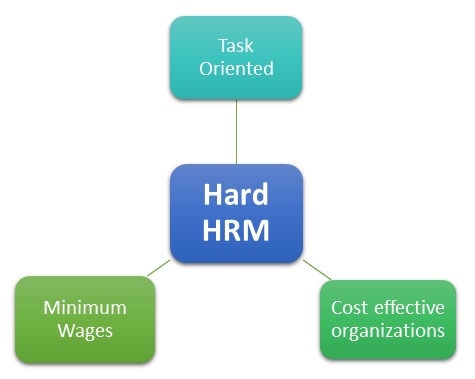- Business Concepts ›
- Human Resources (HR) ›
- Hard HRM
Hard HRM
Definition, Importance & Example
This article covers meaning & overview of Hard HRM from HRM perspective.
What is meant by Hard HRM?
Hard HRM or Hard human resources management means not a very employee friendly human resource management system. Hard HRM is very much task oriented. Though at the base level every organization works for its profits and tasks accomplishment, what differentiates hard HRM is the way they look at the employees, specifically their policies for the employees.
Human resource management is defined as a system of management where the human resources along with their needs are managed in a workplace. Human resource management (HRM) can be categorized into two forms – hard HRM and soft HRM. Hard HRM considers human resources as any other resources like any equipment or machinery. Their main focus relating to the workforce is to recruit them and fire them whenever needed. They pay as much required so you can say they pay the minimum amount a worker should get. Mostly the pay is based on the level of performance of the employees. When HRM is aligned with the strategic goals of the company, it is known as strategic HRM.

Importance of Hard HRM
The concept holds a lot of importance in the corporate sector. As we said human resource management can be categorized as hard HRM and soft HRM, hard HRM has its own importance in the organizations even though it may not sound good at first as compared to soft HRM. Hard HRM are task oriented, this means there is a strict form of hierarchy in the organization. Centralization is there, and most of the decisions are taken by the higher authority. Earlier, all the organizations were a devotee of hard HRM as tasks were the top most priority. Autocratic leadership is a characteristic of hard HRM. No doubt the employees are paid for their job, but the pay is a minimal amount and no such motivation and engagement of employees is there. These type of organizations have a dire need to meet customer demand, and as there are no such emotions for human resources, employee attrition rate is very high. Recruitment policies are planned out as the hiring and firing job is always on. These companies always have opening and job opportunities are high. But in real terms, every organization has some part of its HR in hard form. But now a days the views are changing and even in the sectors which are cost leaders in marketing terms have special policies for employees and their grievances.
Difference between Hard HRM & Soft HRM
Soft HRM is another form of HRM. Here the human resources are considered as assets of the organization. Employee engagement programs are there and also they are motivated to work and remain attached to the organization. Tasks though are priority, employee retention also becomes equally a priority. Soft HRM is mainly observed in organizations encouraging participation of employees and having flat structures.
Example of Hard HRM
Best example of hard HRM would be the manufacturing industries. Industrial relations high lighten hard HRM actually. The workers are paid the minimum wage and the attrition rate is high. The pay is fully based on the performance. No such orientation programs for motivating and engaging the employees is there. Still they have medical bonus pay, leave facilities and also the trade union act supports the industry workers a lot. So manufacturing industry could be an example which has more of hard HRM characteristics, but in real they also do have some soft HRM characteristics. No organization in real is a fully hard or soft HRM based.
Hence, this concludes the definition of Hard HRM along with its overview.
This article has been researched & authored by the Business Concepts Team which comprises of MBA students, management professionals, and industry experts. It has been reviewed & published by the MBA Skool Team. The content on MBA Skool has been created for educational & academic purpose only.
Browse the definition and meaning of more similar terms. The Management Dictionary covers over 1800 business concepts from 5 categories.
Continue Reading:
What is MBA Skool?About Us
MBA Skool is a Knowledge Resource for Management Students, Aspirants & Professionals.
Business Courses
Quizzes & Skills
Quizzes test your expertise in business and Skill tests evaluate your management traits
Related Content
All Business Sections
Write for Us